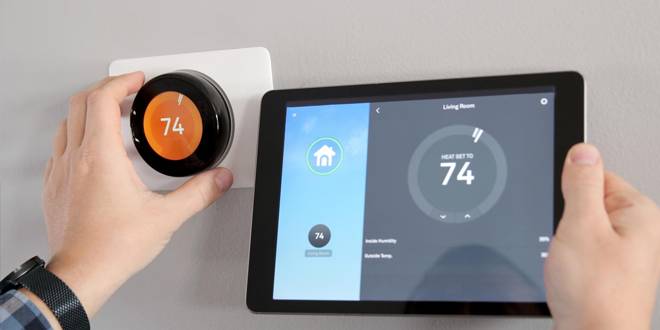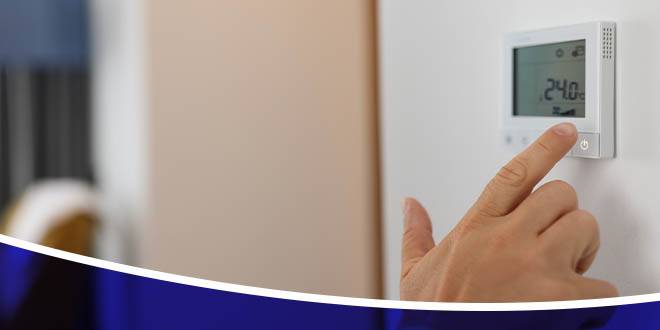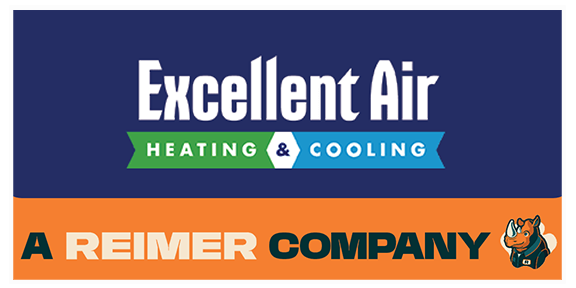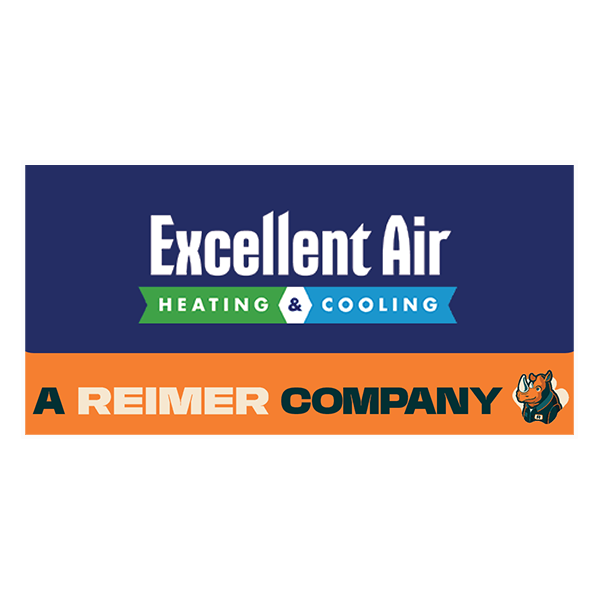Revolutionizing Home Temperature Control
Smart thermostats are a revolutionary technology in the world of home and business temperature control, offering a blend of convenience, efficiency, and cost savings. Here’s everything you need to know about these innovative devices:
What are Smart Thermostats?

Smart thermostats are digital, Wi-Fi-enabled devices that automatically adjust heating and cooling temperature settings in your home or business for optimal performance. Unlike traditional thermostats, they learn from your behaviors, allow remote control of your home’s temperature via a smartphone or computer, and provide detailed reports on energy usage.
How Do Smart Thermostats Work?
Smart thermostats connect to your home or business Wi-Fi network, allowing you to control them remotely through a mobile app or web interface. They use sensors to monitor temperature, humidity, and occupancy in different rooms, adjusting settings accordingly to maintain comfort while minimizing energy use.
Key Features of Smart Thermostats
- Learning Ability: They learn your schedule and preferences, adjusting the temperature automatically.
- Remote Access: Control your heating and cooling system from anywhere using a smartphone or computer.
- Energy Usage Reports: Receive detailed reports on your energy consumption, helping you to understand and reduce your carbon footprint.
- Integration with Smart Home Devices: Most smart thermostats can be integrated with other smart home devices like Amazon Alexa, Google Home, or Apple HomeKit.
7 Benefits of Smart Thermostats
Smart thermostats are more than just a technological upgrade; they are a paradigm shift in how we manage our indoor environments. Here’s an expanded view of their benefits:
1. Energy Efficiency
Automatic Adjustments: Smart thermostats can automatically adjust the temperature based on your daily schedule and habits, ensuring that energy is not wasted heating or cooling an empty house.
Geofencing: Some models use geofencing to detect when you are away from home and adjust the temperature accordingly.
Zoned Heating and Cooling: With compatible systems, they can control temperatures in different areas of your home, reducing energy use in unoccupied spaces.
2. Convenience
Remote Control: Whether you’re in bed or away from home, you can adjust your thermostat using a smartphone, tablet, or computer.
Voice Control: Integration with smart home assistants like Amazon Alexa or Google Assistant allows you to control the thermostat with voice commands.
User-Friendly Interfaces: Modern smart thermostats feature intuitive interfaces, making it easier to set and manage your preferences.
3. Enhanced Comfort
Learning Your Preferences: Over time, smart thermostats learn your preferences and automatically adjust to ensure your comfort.
Sensors: Advanced sensors can detect humidity levels, occupancy, and even the ambient light in a room, adjusting the temperature for optimal comfort.
Pre-Programmed Settings: For immediate comfort, you can choose from pre-programmed settings suited for different situations, like ‘Away’, ‘Home’, or ‘Sleep’.
4. Environmental Impact
Reduced Energy Consumption: By optimizing heating and cooling, these thermostats contribute significantly to reducing household energy consumption.
Eco-Friendly Features: Features like energy reports and eco-mode settings help users make informed choices about their energy use.
Compliance with Green Building Standards: Smart thermostats can help homes and businesses meet green building standards, contributing to broader environmental conservation efforts.
5. Cost Savings
Lower Utility Bills: The energy efficiency of smart thermostats directly translates into lower monthly utility bills.
Long-Term Savings: Though the initial investment is higher than traditional thermostats, the long-term savings on energy bills make smart thermostats a financially wise choice.
Energy Rebates: Many energy companies offer rebates for installing smart thermostats, further reducing the cost.
6. Data Insights and Reports
Energy Usage Reports: Users receive detailed reports on their heating and cooling patterns and energy usage, offering insights into how to optimize energy consumption.
Maintenance Reminders: Some smart thermostats can monitor your HVAC system’s performance and remind you when it’s time for maintenance or filter changes.
7. Integration with Other Smart Home Devices
Seamless Integration: Many smart thermostats can be integrated into broader smart home systems, allowing for centralized control of various home devices.
Automated Home Ecosystem: With the right setup, your thermostat can work in tandem with other devices, like smart blinds, to reduce heating from sunlight, enhancing overall efficiency and comfort.
In summary, smart thermostats provide a comprehensive solution for improving energy efficiency, convenience, comfort, and environmental sustainability in your home or business. As heating and cooling account for a significant portion of energy use in residential and commercial buildings, the adoption of smart thermostats represents a meaningful step towards more sustainable living and working environments.
Smart Thermostat Installation and Compatibility
When considering a smart thermostat for your home or business, understanding the installation process and ensuring compatibility with your existing HVAC system are crucial steps. Here’s an expanded view of these aspects:
Installation Process
- Initial Assessment: Before purchasing a smart thermostat, it’s advisable to assess your current HVAC system and wiring. This includes identifying the type of heating and cooling system you have (e.g., gas, electric, heat pump) and the existing thermostat wiring (commonly known as a C-wire).
- Professional Installation vs. DIY: While many smart thermostats are designed for DIY installation, hiring a professional like us at Excellent Air Heating & Cooling in Rochester, NY, can ensure seamless integration, especially for complex systems.
- Step-by-Step Installation: The installation typically involves removing the old thermostat, connecting the wires to the new device (paying close attention to the manufacturer’s instructions), mounting the new unit, and configuring it via its interface or a connected app.
- Testing Post-Installation: After installation, it’s important to test the thermostat to ensure it’s functioning correctly and efficiently controlling your HVAC system.
Troubleshooting Common Issues: If you encounter any difficulties with your smart thermostat, such as it not responding or failing to control the temperature effectively, we have prepared a resourceful guide for you. Visit our AC thermostat not working tips for easy-to-follow troubleshooting advice that can help you quickly resolve most issues and ensure your thermostat functions as intended.
Compatibility Considerations
- HVAC System Type: Not all smart thermostats are compatible with every type of HVAC system. It’s essential to confirm whether the chosen model works with your specific heating and cooling system.
- Wiring Requirements: Many smart thermostats require a C-wire to provide continuous power for features like Wi-Fi connectivity and digital displays. If your system doesn’t have a C-wire, some models come with adapters, or you might need to have one installed.
- Multi-Stage Heating and Cooling Systems: For homes or businesses with multi-stage systems or those with accessories like humidifiers or ventilators, it’s important to choose a thermostat that can handle these complexities.
- Zoning Systems: If your property uses zoning systems for heating and cooling different areas, you’ll need a smart thermostat that can accommodate this.
Brand and Model Specifics
Popular Brands: Brands like Nest, Ecobee, and Honeywell offer a range of models with varying features. Each brand has its unique strengths, compatibility criteria, and user interfaces.
Software Compatibility: Ensure that the thermostat’s software is compatible with your smartphone or computer for remote control. This includes checking the app’s compatibility with your device’s operating system (iOS, Android, etc.).
Additional Considerations
Wireless Connectivity: Ensure your Wi-Fi network has sufficient range and strength to consistently connect to the thermostat.
Future Upgrades: Consider whether the thermostat will integrate with future smart home upgrades or HVAC system changes.
Energy Management Systems: For businesses, compatibility with larger energy management systems can be a key factor.
Professional Consultation
Expert Advice: Consulting with HVAC professionals can provide insights into the best smart thermostat options for your specific needs and ensure proper installation and integration.
Local Regulations and Rebates: Professionals like us can also advise on any local regulations or available rebates for smart thermostat installation in your area, such as those in Rochester, NY.
Cost and ROI of Smart Thermostats: An In-Depth Analysis
The adoption of smart thermostats is often viewed through the lens of cost versus return on investment (ROI). While the initial cost may be higher than traditional thermostats, the long-term benefits and savings can be substantial. Here’s a detailed look at the cost and ROI associated with smart thermostats:
Initial Costs
Purchase Price: Smart thermostats typically range in price depending on the brand, model, and features. Higher-end models with advanced features like learning algorithms and extensive smart home integration will cost more.
Installation Costs: If you opt for professional installation, especially for complex HVAC systems or in cases where new wiring (like a C-wire) is needed, there will be additional costs. However, many models are designed for DIY installation, which can save on these expenses.
Additional Accessories: Some systems may require additional accessories, like a separate sensor for remote rooms or an adapter if a C-wire isn’t available.
Energy Savings
Reduced Energy Bills: Smart thermostats can save up to 10-23% on heating and 15% on cooling costs annually, according to various studies. These savings are realized through efficient temperature management and the reduction of energy wastage.
Customized Scheduling: By allowing for detailed scheduling and automatic adjustments based on presence or absence in the home, smart thermostats ensure energy is not used unnecessarily.
Energy-Efficient Features: Features like geofencing, eco-modes, and the ability to respond to utility price signals (in some regions) contribute to further energy savings.
Return on Investment (ROI)
Break-Even Point: The time it takes to recoup the initial investment through energy savings can vary. On average, users may see a return within 1-3 years, depending on the thermostat model, usage patterns, and energy prices.
Long-Term Savings: Over the lifespan of a smart thermostat (which can be several years), the cumulative energy savings can be significant, making it a financially sound investment in the long term.
Other Financial Considerations
Rebates and Incentives: Some energy companies and local governments offer rebates or incentives for installing energy-efficient devices like smart thermostats. This can offset the initial purchase cost.
Home Value Increase: The installation of smart home technology, including smart thermostats, can increase the appeal and value of a property, which can be a consideration for those looking to sell or rent their property.
Beyond Monetary ROI
Environmental Impact: By reducing energy consumption, smart thermostats contribute to lowering your carbon footprint, an important consideration in today’s environmentally conscious world.
Comfort and Convenience: The enhanced comfort and convenience offered by smart thermostats, though not quantifiable in monetary terms, contribute to the overall ROI in terms of quality of life.
In summary, while the upfront cost of a smart thermostat is higher than that of a conventional thermostat, the long-term energy savings, environmental benefits, and enhanced living comfort they offer present a compelling case for their adoption. The actual ROI will depend on various factors, including individual usage patterns, local energy costs, and the specific features of the thermostat chosen.
Choosing the Right Smart Thermostat Model

Consider features like learning capabilities, compatibility with your HVAC system, integration with other smart devices, and user-friendliness. Brands like Nest, Ecobee, and Honeywell offer popular models with varying features to suit different needs.
Selecting the ideal smart thermostat for your home or business involves considering various factors to ensure you get the most out of your investment. Here’s an in-depth look at the key considerations:
Learning Capabilities
Self-Learning Thermostats: Some smart thermostats have the ability to learn your schedule and temperature preferences over time, automatically adjusting settings for optimal comfort and efficiency.
Adaptive Scheduling: Look for models that adapt to seasonal changes and adjust heating or cooling schedules accordingly.
Compatibility with HVAC System
System Type: Ensure the thermostat is compatible with your specific type of heating and cooling system (e.g., gas, electric, forced air, hydronic, heat pump).
Voltage Requirements: Check the voltage compatibility, as some thermostats are designed for low-voltage systems, while others can handle line-voltage systems.
Integration with Smart Home Devices
Smart Home Ecosystems: Consider how well the thermostat integrates with existing smart home platforms like Amazon Smart Thermostat, Google Home, or Apple HomeKit.
IFTTT (If This Then That) Support: Some thermostats support IFTTT, enabling them to interact with other IFTTT-compatible smart devices and create custom automation rules.
User-Friendliness
Interface: Look for a thermostat with an intuitive interface, both on the device itself and its accompanying app.
Remote Access: Ensure the thermostat offers a user-friendly app that allows you to control settings from your smartphone or tablet.
Additional Features
Sensors: Some models come with remote sensors to measure temperature and occupancy in different rooms for more precise climate control.
Geofencing: This feature uses your smartphone’s location to adjust your home’s temperature based on your proximity to home.
Energy Reports: Models that provide detailed energy usage reports can help you understand your consumption patterns and identify opportunities for additional savings.
Aesthetics and Design
Display and Build: Consider the display quality and the overall design of the thermostat, as it should blend well with your home’s interior.
Touchscreen vs. Buttons: Decide between a touchscreen interface or physical buttons, based on your preference.
Brand-Specific Features
- Nest: Known for its learning capabilities and sleek design.
- Ecobee (Smart Thermostat Premium): Offers remote sensors and is often praised for its extensive smart home integration.
- Honeywell: Known for a wide range of models catering to different needs and budgets, with strong reliability.
Price and Warranty
Budget: Determine your budget, as prices can vary widely based on features and brand.
Warranty and Support: Check the warranty period and the type of customer support offered by the manufacturer.
Reviews and Recommendations
Customer Reviews: Look at customer reviews to understand real-world performance and reliability.
Professional Recommendations: Consult with HVAC professionals for recommendations based on your specific needs and their experiences with different models.
In conclusion, choosing the right smart thermostat involves balancing functionality, compatibility, ease of use, and budget. It’s important to research and possibly consult with HVAC experts like us at Excellent Air Heating & Cooling in Rochester, NY, to find a model that aligns with your specific needs and enhances the comfort and efficiency of your space.
Privacy and Security
As with any connected device, there are privacy and security considerations. Choose a thermostat from a reputable brand, regularly update its software, and ensure your home Wi-Fi network is secure.
Ready for Smarter Temperature Control?
🌡️ Embrace the future of home and business climate management today! Call Excellent Air Heating & Cooling for expert guidance on selecting and installing the perfect smart thermostat. Upgrade your comfort and efficiency now! 🏡💼 Contact us today and start your journey towards a smarter, more energy-efficient future. 📞💻🌍








